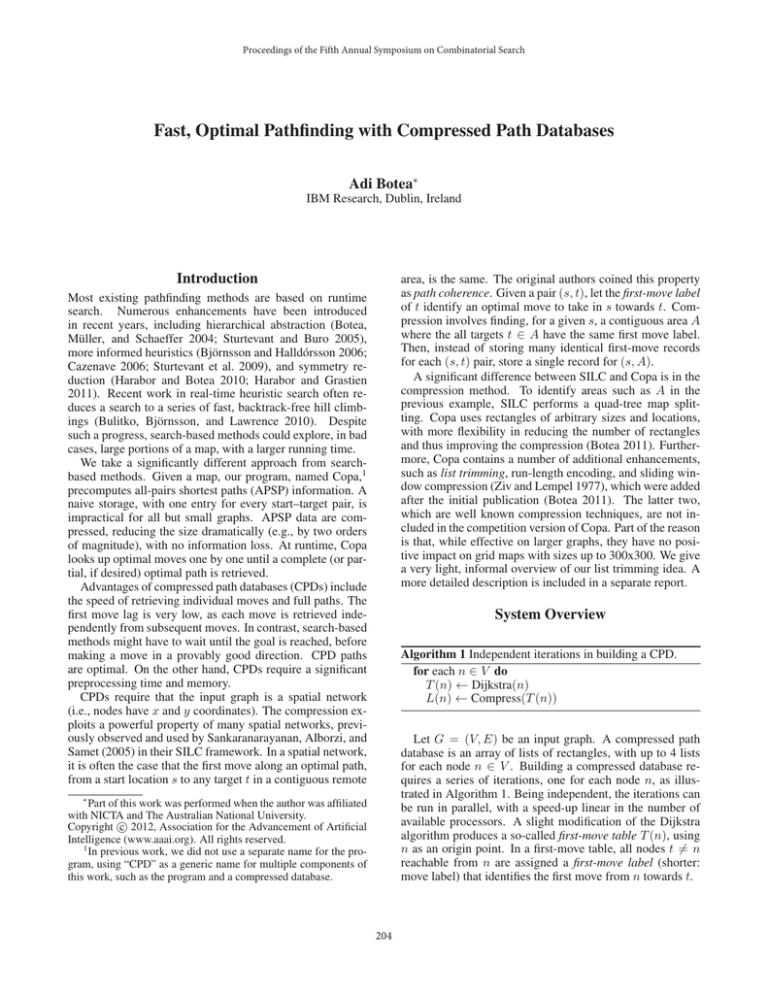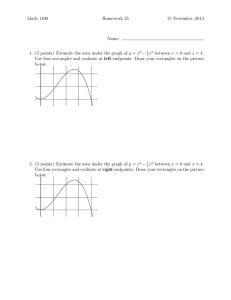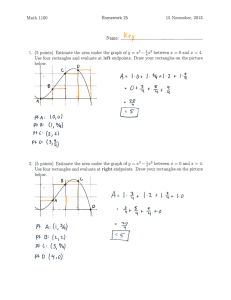
Proceedings of the Fifth Annual Symposium on Combinatorial Search
Fast, Optimal Pathfinding with Compressed Path Databases
Adi Botea∗
IBM Research, Dublin, Ireland
Introduction
area, is the same. The original authors coined this property
as path coherence. Given a pair (s, t), let the first-move label
of t identify an optimal move to take in s towards t. Compression involves finding, for a given s, a contiguous area A
where the all targets t ∈ A have the same first move label.
Then, instead of storing many identical first-move records
for each (s, t) pair, store a single record for (s, A).
A significant difference between SILC and Copa is in the
compression method. To identify areas such as A in the
previous example, SILC performs a quad-tree map splitting. Copa uses rectangles of arbitrary sizes and locations,
with more flexibility in reducing the number of rectangles
and thus improving the compression (Botea 2011). Furthermore, Copa contains a number of additional enhancements,
such as list trimming, run-length encoding, and sliding window compression (Ziv and Lempel 1977), which were added
after the initial publication (Botea 2011). The latter two,
which are well known compression techniques, are not included in the competition version of Copa. Part of the reason
is that, while effective on larger graphs, they have no positive impact on grid maps with sizes up to 300x300. We give
a very light, informal overview of our list trimming idea. A
more detailed description is included in a separate report.
Most existing pathfinding methods are based on runtime
search. Numerous enhancements have been introduced
in recent years, including hierarchical abstraction (Botea,
Müller, and Schaeffer 2004; Sturtevant and Buro 2005),
more informed heuristics (Björnsson and Halldórsson 2006;
Cazenave 2006; Sturtevant et al. 2009), and symmetry reduction (Harabor and Botea 2010; Harabor and Grastien
2011). Recent work in real-time heuristic search often reduces a search to a series of fast, backtrack-free hill climbings (Bulitko, Björnsson, and Lawrence 2010). Despite
such a progress, search-based methods could explore, in bad
cases, large portions of a map, with a larger running time.
We take a significantly different approach from searchbased methods. Given a map, our program, named Copa,1
precomputes all-pairs shortest paths (APSP) information. A
naive storage, with one entry for every start–target pair, is
impractical for all but small graphs. APSP data are compressed, reducing the size dramatically (e.g., by two orders
of magnitude), with no information loss. At runtime, Copa
looks up optimal moves one by one until a complete (or partial, if desired) optimal path is retrieved.
Advantages of compressed path databases (CPDs) include
the speed of retrieving individual moves and full paths. The
first move lag is very low, as each move is retrieved independently from subsequent moves. In contrast, search-based
methods might have to wait until the goal is reached, before
making a move in a provably good direction. CPD paths
are optimal. On the other hand, CPDs require a significant
preprocessing time and memory.
CPDs require that the input graph is a spatial network
(i.e., nodes have x and y coordinates). The compression exploits a powerful property of many spatial networks, previously observed and used by Sankaranarayanan, Alborzi, and
Samet (2005) in their SILC framework. In a spatial network,
it is often the case that the first move along an optimal path,
from a start location s to any target t in a contiguous remote
System Overview
Algorithm 1 Independent iterations in building a CPD.
for each n ∈ V do
T (n) ← Dijkstra(n)
L(n) ← Compress(T (n))
Let G = (V, E) be an input graph. A compressed path
database is an array of lists of rectangles, with up to 4 lists
for each node n ∈ V . Building a compressed database requires a series of iterations, one for each node n, as illustrated in Algorithm 1. Being independent, the iterations can
be run in parallel, with a speed-up linear in the number of
available processors. A slight modification of the Dijkstra
algorithm produces a so-called first-move table T (n), using
n as an origin point. In a first-move table, all nodes t 6= n
reachable from n are assigned a first-move label (shorter:
move label) that identifies the first move from n towards t.
∗
Part of this work was performed when the author was affiliated
with NICTA and The Australian National University.
c 2012, Association for the Advancement of Artificial
Copyright Intelligence (www.aaai.org). All rights reserved.
1
In previous work, we did not use a separate name for the program, using “CPD” as a generic name for multiple components of
this work, such as the program and a compressed database.
204
←
.
.
.
.
←
.
.
.
.
←
.
.
.
.
% % % %
% % %
% %
%
%
%
.
. . .
. . . . .
. . . . . . .
←
.
.
↑
↑
↑
↑
n
↓
%
%
%
%
→
% % %
% % %
% %
%
.
. .
. .
.
. . .
. . . . . .
% %
%
% %
% %
% %
% %
%
%
%
%
%
get by simply comparing the coordinates of n and t. Then,
the corresponding list of rectangles Lc (n) is parsed in order
until the rectangle ρ containing t is found. The move label
of ρ is precisely the move (i.e., edge) e to take from node
n. In the worst-case, the entire list Lc (n) has to be parsed
to retrieve the move. The average case is much better, given
that the rectangles in a list Lc (n) are ordered decreasingly
according to the number of contained reachable targets.
Finally, we illustrate list trimming, a feature that eliminates part of the rectangles in a sector list with no information loss. All rectangles removed from a given sector list
have to have the same first-move label l. Assume a trimmed
sector list is parsed at runtime, looking for the rectangle that
contains the target (method retrieveMove, Alg. 2). If no such
a rectangle is found, we know that the rectangle needed has
been removed, and therefore it must have the move label l.
Hence, l is the move to return by method retrieveMove.
List trimming’s impact on move retrieval speed can be
either positive or negative depending on the number of the
removed rectangles, and their position in the sector list. It
can be shown that, after selecting a move label l, an optimal
trimming policy is to start removing rectangles from the end
of the list, without skipping any rectangle with the move
label l. If the expected move retrieval time does not increase,
remove the rectangle and repeat the step. Otherwise, we
have a memory vs speed trade-off, and whether to continue
with the trimming or not depends on the user preferences. In
our experiments, list trimming reduces the database size by
a factor close to 2, with no negative impact on the speed.
Figure 1: A first-move table on a toy grid map.
Figure 1 shows an example of a move table on a toy,
8-connected grid map, for a given origin point labelled n.
Blocked cells are black. All traversable cells except for
n have a move label represented in the picture with arrows with various orientations. For example, labelling the
bottom-right cell of the grid with . states that the first move
from n towards that cell should be South-West. Notice in the
picture how path coherence allows first-move data to cluster,
offering an opportunity to compress the data.
The second step in an iteration in Algorithm 1 is decomposing a first-move table into disjoint homogeneous rectangles. A rectangle ρ is homogeneous if all nodes contained
in ρ have the same move label. Homogeneous rectangles
are allowed to contain blocked (or unreachable) areas. This
helps obtaining a better compression, as there is no need to
separate between such different types of areas.
First-move table decomposition is a recursive process.
First, 4 or fewer rectangular sectors, depending on whether
n is inside or on the edge of the map, are identified around
n. There is one sector at the North-West (NW) of the origin,
which in our example contains the upper left sector with 4
rows and 5 columns. The North-East (NE) sector has 4 rows
and the 11 rightmost columns. The South-West (SW) sector
has 5 rows and 5 columns, whereas the South-East (SE) one
has 5 rows and 11 columns. Non-homogeneous sectors are
split with a greedy procedure (Botea 2011) until all rectangles are homogeneous. For example, the NW sector is not
homogeneous, as it has two types of move labels (i.e., and ↑). In summary, the decomposition leads to up to 4 lists
of rectangles associated with the origin node n. Each list,
called a sector list, corresponds to one sector (e.g., NW).
In the example, the decomposition leads to 12 rectangles
in total: 2 rectangles in the NW sector, one in the NE sector,
5 rectangles in the SE sector, and 3 in the SW sector.
References
Björnsson, Y., and Halldórsson, K. 2006. Improved heuristics for optimal path-finding on game maps. In AIIDE, 9–14.
Botea, A.; Müller, M.; and Schaeffer, J. 2004. Near optimal
hierarchical path-finding. Journal of Game Dev. 1:7–28.
Botea, A. 2011. Ultra-fast Optimal Pathfinding without
Runtime Search. In Proceedings of AIIDE-11, 122–127.
Bulitko, V.; Björnsson, Y.; and Lawrence, R. 2010. Casebased subgoaling in real-time heuristic search for video
game pathfinding. J. Artif. Intell. Res. (JAIR) 39:269–300.
Cazenave, T. 2006. Optimizations of data structures, heuristics and algorithms for path-finding on maps. In CIG, 27–33.
Harabor, D., and Botea, A. 2010. Breaking path symmetries
in 4-connected grid maps. In AIIDE-10, 33–38.
Harabor, D., and Grastien, A. 2011. Online graph pruning
for pathfinding on grid maps. In AAAI-11.
Sankaranarayanan, J.; Alborzi, H.; and Samet, H. 2005. Efficient query processing on spatial networks. In ACM workshop on Geographic information systems, 200–209.
Sturtevant, N., and Buro, M. 2005. Partial Pathfinding Using
Map Abstraction and Refinement. In AAAI, 47–52.
Sturtevant, N. R.; Felner, A.; Barrer, M.; Schaeffer, J.; and
Burch, N. 2009. Memory-based heuristics for explicit state
spaces. In Proceedings of IJCAI, 609–614.
Ziv, J., and Lempel, A. 1977. A universal algorithm for
sequential data compression. IEEE Transactions on Information Theory 23(3):337–343.
Algorithm 2 Retrieving a path at runtime for an (s, t) pair.
n ← s {initialize current node}
while n 6= t do
e ← retrieveMove(n, t)
n ← node after move e
Algorithm 2 retrieves moves one by one in order. Method
retrieveMove first identifies the sector c that contains the tar-
205





